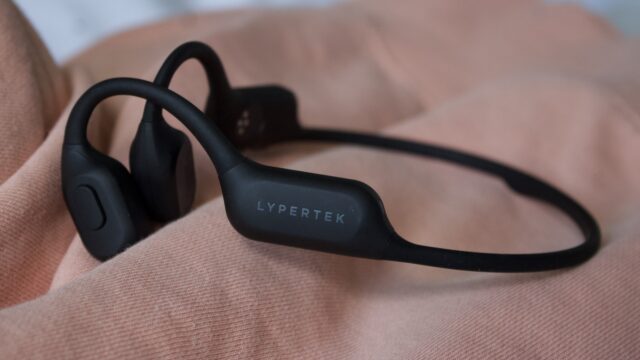Verdict
The Lypertek Soundfree S30 offers good sound and performance for the price, but spending a bit more can get you a much more polished open-ear headphone experience.
-
Reasonably good open-ear sound -
Good value for music player and Bluetooth streaming -
Comfortable and lightweight design
-
Uncomfortable vibration tickle at moderate to loud volumes -
Sound quality doesn’t stand out from open-ear crowd -
Battery drop in music player mode
Key Features
-
32GB of storage
Storage music on the headphones -
IP68 waterproof rating
Use for swimming with its waterproof design -
EQ boost
Switch between Bass, Balanced and Vocal modes
Introduction
The Lypertek Soundfree S30 is another model that’s joined the ranks of open-ear headphones. Unlike bone conduction and air conduction ones, the Soundfree S30 uses cartilage conduction technology to generate sound.
Along with the option of Bluetooth or music player streaming, the Soundfree S30 packs in EQ modes, multipoint sharing and even wants to help keep you seen when you’re wearing them at night all without needing an additional app.
They sit at a price that means they’re competing with some pretty good open-ear headphones. Do they hold their own and should these be open-ear headphones to grab
For workouts, swims and everything in between? Here’s my take.
Price
The Lypertek Soundfree S30 launched in August 2025 and are mainly available to buy through Lypertek’s own website. They are priced at £79.95 / $99.99, which make them a pretty affordable pair of open-ear headphones.
Given that they offer both Bluetooth and music player streaming, that makes them pretty well priced against the competition. The Shokz OpenSwim Pro 2 costs £169 in comparison, while you’ll also pay more for the Suunto Aqua (£159) and the H20 Audio Tri 2 Pro (£188).
There are some other cartilage conduction headphones options likethe Audio Technica ATH-CC500BT2 (£119), which again, are slightly more expensive and also only offer Bluetooth streaming.
Design
- Titanium and silicone design
- Physical controls
- IP68 waterproof rating
The Soundfree S30 adopts a pretty familiar neckband-style design seen on other open-ear, bone conduction headphones including the likes of Shokz.
That’s a flexible frame made from titanium, covered in silicone that’s lightweight yet durable and doesn’t put metal directly in contact with your head or neck.
To give them added appeal for swimmers, they’re waterproof and dustproof thanks to an IP68 certified design. It’s also TUV-certified for submersion in water up to 10 metres deep.

Wearing them feels a lot like whipping on a pair of Shokz headphones. At 23g, they’re lighter than both the Shokz OpenRun Pro 2 and the OpenSwim Pro, and the general stature of the Soundfree S30 means they sit similarly to Shokz’ headphones.
They’re extremely comfortable and unobtrusive to wear, and unlike a lot of Shokz-like rivals, you can largely forget about them when they’re on.
That even extends to the layout of the physical buttons. There’s two on the underside of the right arm and a larger, single one on the outside of the left arm, pretty much where Shokz and a host of other Shokz-like headphones put those controls.


Those controls allow you to adjust volume, skip back and forward a track, toggle through the available EQ modes and along with the onboard dual-mic array handle calls from them as well. The physical controls work well on the whole. Whether out on a run, in the pool or just sitting at a desk, this seems to be a control setup pretty much settled on for neckband headphones, and rightly so because it works well and it’s no different here.
While not immediately obvious, these headphones do have another trick up their sleeve. There’s also a set of small LED lights that pulsate at the back of the headphones and are designed to make them more suitable for use at night or in general lower-lit conditions. The likes of Suunto and Philips have offered something similar on their open-ear headphones. It’s a nice added safety touch if not exactly the brightest largest source of additional light.
Features
- 3 EQ modes and 32GB storage
- Up to 8 hours battery life
You have the option of Bluetooth or music player streaming with the former offering the latest Bluetooth 6.0 to wirelessly connect to your devices. When you want to load audio onto the headphones, there’s 32GB of storage giving you approximately enough room for 8,000 songs. To get that audio on, you’ll need to plug them into a computer and drag and drop files on.
While you’ll need to own that music, it does at least support multiple file formats such as MP3, FLAC, WAV, WMA, APE, and M4A. It can be a bit slow going as dragging and dropping single files wasn’t exactly a speedy process.


If you’re using them for calls, listen to podcasts or audiobooks or a scenario where voices need to be prioritised, they are up to the task. The call quality just isn’t that different from other open-ear headphones.
In terms of battery life, the Lypertek Soundfree S30 promises up to 8 hours of continuous listening. Though as is often the case, this isn’t clarified whether this when using it for Bluetooth streaming or MP3 streaming. Based on testing, this would appear to apply to Bluetooth streaming where an hour’s use saw battery anywhere from 10-12%. When I switched to music player streaming for the same amount of time, it dropped by 30%.
To charge them back up can take as long as 2.5 hours and there isn’t any sort of quick charge mode seen on other open-ear headphones and earbuds.


Sound Quality
As mentioned, the Soundfree S30 uses cartilage conduction in contrast to the bone conduction technology approach used by most other neckband-style open-ear headphones. There’s certainly more similarities with cartilage conduction and bone conduction.
It still creates sound through vibrations, though unlike bone conduction, it’s about channelling them through the cartilage of the ear to the wall of the ear canal and towards the cochlea.
The idea is that sound is pushed towards the ear without entirely blocking the area with sound. In theory, it should deliver higher quality sound than bone conduction and also remove side effects of that technology, like vibration tickle at louder volumes.


So, how do things play out? Having tested a lot of bone conduction, air conduction and the other notable set of cartilage conduction headphones, the Soundfree S30 sound fine, but I wouldn’t say these are necessarily top tier or do live up to some of the promises made adopting that cartilage conduction approach.
One redeeming and not so desirable quality about the listening experience is that you do get some noticeable vibration tickle when using at louder volumes or with anything that’s got some meaty bass. This is something I didn’t experience on Audio Technica’s cartilage conduction headphones..
There’s your pick of Balanced, Vocal and Bass EQ modes and I think there’s some nice qualities with those modes which you can switch between directly on the headphones.
On Massive Attack’s Unfinished Sympathy, I toggled between Balanced and Bass modes. In the former, the bass performance feels very much in keeping with a lot of open-ear headphones at around this price.
By that I mean a bit underwhelming, not so super balanced with a stronger emphasis on clarity and treble performance, which did help to elevate the vocals on the track. I switched to bass mode and the bass profile was muddy and any sense of balance from the Balanced mode disappeared.


On Jill Scott’s Golden, there’s a continuation of that woolly-feeling bass where that Balanced mode offers something more likeable, but there’s still that presence of the vibration tickle and mids aren’t exceptionally detailed. On Soft Cell’s Say Hello, Wave Goodbye, I switched between those Balanced and Bass modes and again it doesn’t quite sparkle in either modes.
In terms of delivering a good, open-ear experience, the Soundfree S30 does an okay job. I’ve used them for working at a desk, taking walks, going for runs indoors and outdoors and for swims. They could do with being a bit louder, though as explained, that introduces problems.
In moderately loud environments and for swims, they offered a good mix of internal and external sound. When things do get louder around you, they’re a little easier to drown out than similar headphones.
Should you buy it?
You want open-ear headphones with Bluetooth and MP3 streaming
The Lypertek Soundfree S30 offers okay open-ear sound and two streaming options at a pretty likeable price
You want the best-sounding open-ear headphones
There are definitely more exciting, higher quality sounding alternatives you could spend a little more on
Final Thoughts
The Lypertek Soundfree S30 are certainly open-ear headphones that take a lot of inspiration from the competition and offer features like music player streaming for less than its rivals.
As far as sounding better than those rivals, I’d say the Soundfree S30 didn’t quite blow me away. They don’t sound bad and I’d be happy using them in most scenarios but they don’t stand out and there’s also that noticeable vibration tickle. I’d also say that Audio Technica’s cartilage conduction headphones sounded better in comparison.
This is a better all-round package in terms of features and value than the Audio Technica ATH-CC500BT2, but if you want the best-sounding open-ear headphones in and around this price, I think there’s better options.
How We Test
We test every pair of headphones we review thoroughly over an extended period of time. We use industry-standard tests to compare features properly. We’ll always tell you what we find.
We never, ever, accept money to review a product.
Find out more about how we test in our ethics policy.
- Tested for two weeks
- Tested with real-world use
FAQs
Yes, the Lypertek Soundfree S30 is waterproof and is suitable for swimming and being submerged in water up to 10 metres depth.
Full Specs
| Lypertek SoundFree S30 Review | |
|---|---|
| UK RRP | £89.99 |
| USA RRP | $99.99 |
| Manufacturer | Lypertek |
| IP rating | IP68 |
| Battery Hours | 8 |
| Weight | 23 G |
| ASIN | B0FKMZLMTP |
| Release Date | 2025 |
| Audio Resolution | SBC, AAC, MP3, FLAC, WAV, WMA, APE, M4A |
| Connectivity | Bluetooth 6 |
| Colours | Black |
| Frequency Range | 100 5000 – Hz |
| Headphone Type | On-ear (Open) |
| Sensitivity | 98 dB |











